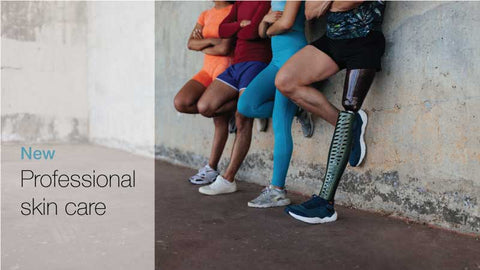Medicare and Prosthetic Limbs: Coverage for Amputees Explained
Reading Time: 5 minutes
___
Summary:
-
Medicare covers prosthetic limbs for amputees when medically necessary
-
Microprocessor knee coverage expanded to K2 users as of September 2024
-
Repairs, replacements, and advanced prosthetics require proper documentation
-
Medicare Advantage and Medigap plans may reduce out-of-pocket prosthetic costs
___
Prosthetic limbs do more than restore mobility—they help individuals living with limb loss or limb difference regain independence and confidence. They enable people to return to their daily activities, reconnect with their communities, and reclaim their sense of self. However, these life-changing devices often cost thousands of dollars, making it crucial for Medicare beneficiaries to understand what’s covered and what’s not.

What prosthetic devices does Medicare cover?
Medicare covers artificial limbs (arms and legs) when they’re medically necessary and prescribed by a Medicare-enrolled doctor.
Covered items include:
-
Below-knee or above-knee prostheses
-
Sockets, liners, pylons, and suspension systems
-
Microprocessor-controlled knees and ankles (for qualified users)
-
Adjustments and repairs
Some surgical options—such as osseointegration, where a metal implant attaches to bone—may also qualify, but coverage is reviewed on a case-by-case basis by your local Medicare Administrative Contractor (MAC).
Does Medicare cover microprocessor knees?
Yes. Starting September 1, 2024, Medicare has expanded coverage for microprocessor-controlled knees (MPKs). Previously, only higher-functioning amputees (K3 or K4) qualified. Now, even K2-level users—those who walk limited distances in their community—may qualify.
To be covered, your K-level (functional mobility level) must be documented; your provider must demonstrate that the device is reasonable and necessary, and documentation should describe daily activities and ambulation potential.
What about osseointegration?
Osseointegration—a bone-anchored implant that replaces a prosthetic socket—may also be covered by Medicare, but it’s not automatic. Medicare does not have a national coverage determination for osseointegration. Each case is evaluated by your local MAC for medical necessity, so strong documentation of functional improvement is crucial.
Repairs and replacements
Medicare covers repairs and adjustments when your prosthesis requires maintenance. If repair costs surpass 60% of the price of a new device, Medicare might approve a replacement instead, as long as all coverage criteria are met.
What are the costs in 2025?
Even with Medicare coverage, amputees still face some out-of-pocket costs. Here’s a breakdown of what to expect.
Part A (Hospital Insurance)
Covers surgical prosthetic implants (e.g., osseointegration) and hospital stays.
-
Deductible: $1,676 per benefit period.
-
Cost: $0 for hospital days 1-60 after the deductible.
-
Note: Coverage for osseointegration is determined on a case-by-case basis and is not guaranteed nationwide.
-
2026 Cost: As of this writing, the 2026 figures are not final and have yet to be announced. However, some analysts project it will be $1,716.
Part B (Medical Insurance)
Covers external prosthetic limbs and related components, such as prosthetic liners, sockets, and pylons.
-
Deductible: $257 per year
-
Coinsurance: You pay 20% of the Medicare-approved amount
-
Requirements: Device must be deemed medically necessary, ordered by a Medicare-enrolled doctor, and supplied by a Medicare-enrolled prosthetist
-
Prior Authorization: Required in some states for certain devices, including MPKs
-
2026 Cost: As of this writing, the 2026 figures are not yet final and have not been announced. However, some analysts project that it will be $288.
Part C (Medicare Advantage)
Private Medicare Advantage plans are required to cover at least what Original Medicare provides but may also offer: different copays or deductibles, network restrictions for prosthetists or hospitals, and additional rehab or therapy benefits.
Before enrolling or switching plans, ensure that your prosthetist and device are in-network and verify if prior authorization is necessary.
For 2026, CMS has already announced a 5.06% increase in Medicare Advantage payment rates.
Medigap (Supplemental Insurance)
If you have Original Medicare, a Medigap plan can assist with:
-
The 20% coinsurance after Part B
-
Hospital deductibles under Part A
This coverage can lower costs for ongoing treatments or advanced prosthetic technology.
How to make sure you’re covered
To ensure you’re adequately covered, you need to do the following:
-
Obtain a prescription from a Medicare-enrolled doctor
-
Collaborate with a Medicare-enrolled prosthetist or supplier
-
Verify that your functional level (K-level) and goals are documented
-
Inquire about prior authorization before ordering advanced components
-
Consider enrolling in a Medigap plan or a Medicare Advantage plan that offers comprehensive prosthetic coverage
Additionally, you can use the Medicare Supplier Directory to find approved suppliers.
Related Reading:
Health Insurers Cut Back on Prosthesis Coverage Over Medical Doubts
The Battle for Mobility: Insurance Denials and Prosthetic Access
How to Afford a Prosthetic Limb: Grants, Programs, and Funding Resources for Amputees









































































